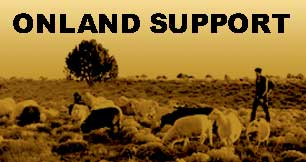Black Mesa Project Controversy Rises
October 25, 2008 by pathfinder
Filed under Latest Posts
A Waning Administration’s Actions May Contribute to a Tribal Mining Dispute.
By Carol Berry, Today correspondent; Indian Country Today, Oct 25, 2008
BLACK MESA, Ariz. – A push to approve a Peabody Western Coal Co. project in northern Arizona may be dividing the Hopi Tribal Council and fueling an attempted ouster of the tribal chairman.
“They have suspended my authority and one of the principal reasons is they want to ramrod the [Black Mesa project] EIS [environmental impact statement] through,” said Ben Nuvamsa, who asserted Oct. 17 that he plans to file a motion to quash an arrest warrant issued by a tribal judge over his contested chairmanship.
“They want to get it through before the presidential election and before a new administration takes office,” Nuvamsa said by telephone.
At issue are varying perceptions of Peabody Coal and its motives, and the pros and cons of the Black Mesa project itself, which would incorporate nearly 19,000 acres associated with the Black Mesa mining operation into an expanded permit area that now includes the Kayenta Mine.
The mines, which sit atop the vast coal reserves of Black Mesa, are different things to different interests: a potential source of jobs for Native miners, an economic boost for the area’s tribal nations, a concern for some traditionalists and for various environmental groups, a source of profit for Peabody and a headache for others, including the U.S. Office of Surface Mining.
Above all, Black Mesa appears to have been a contentious issue in Hopi country, dividing communities and the tribal council itself, whose very ability to function is viewed differently by opposing factions in a conflict described by one observer as “totally political.”
“It’s a very controversial project,” conceded Rick Holbrook, who is overseeing the OSM’s Black Mesa Project EIS, due to be finalized in November.
But there has been no particular pressure from the administration to rush completion of the environmental study, which represents the government’s final decision on the project, said Holbrook, who is in OSM’s regional office in Denver.
“We’re just moving along, trying to get it done,” he said by telephone. “From our perspective, it’s time to bring it to a close and make a decision.”
Others disagree, however, among them a Sierra Club tribal partnership program spokesman.
“In the waning days of the Bush administration, they’re pushing that through as part of a fire sale,” said Andy Bessler by telephone. “But it’s not fair to the Hopi and Navajo communities to push it through like that.”
Vernon Masayesva, founder of Black Mesa Trust and a former Hopi tribal chairman, said he didn’t know about direct administration intervention in the EIS process, but “one of the persons on the cooperating agency team supposedly said they were under a lot of pressure to do the EIS before the next administration comes in.”
Lame-duck urgency aside, it is clear that there are other concerns about the proposed mine extension itself, whose purpose Holbrook described as continuing to supply coal to the Navajo Generating Station near Page via an approximately 75-mile railway. The station serves electricity customers in Arizona, Nevada and California.
“We are the owners of the resource and we should not be in a situation where we are a cooperating agency but not a decision-making entity,” said Nuvamsa, who is concerned that, in addition to the preferred EIS alternative, other potentially damaging alternative plans remain in the EIS.
The environmental study of this coal delivery system – scaled down from earlier versions – arose from Peabody’s request to OSM to “wrap the permit boundary around the area that heretofore had not been permitted: the Black Mesa mining area,” Holbrook said.
Extension of the boundary would permit the use of joint office and other facilities in an area now shared with the permitted Kayenta Mine in the Black Mesa Complex, he said, but no customer has been identified for any additional coal that might be produced – raising questions about the purpose behind the company’s request to include Black Mesa within the wider, long-term mining permit.
The EIS process requires OSM to identify the most likely future condition in order to assess project impacts; but, Holbrook said, “there’s no potential customer in the future that we could positively identify,” noting Peabody could be thinking of a coal conversion plant or “they could be talking to Asian countries – who knows?”
Since there is no identified customer for Black Mesa coal and since there is sufficient existing coal to continue supplying the Navajo Generating Station until 2026, “it appears [to Black Mesa Trust] they are doing that [extending the permit to wider coal reserves] to add value to their portfolio so they can sell it to China. China and Russia are buying up reserves all over the world,” Masayesva said by telephone.
“No customer means no project – you can’t do an EIS unless you have a real project, yet OSM is going ahead with getting a life-of-mine [renewable] permit. What’s the justification?
The haste some perceive in finishing the EIS, coupled with an embedded mistrust of both Peabody Western Coal Co. and federal agencies on the part of other tribal members, has created what Masayesva terms a “dysfunctional” tribal government that could not officially approve the Black Mesa Project final EIS.
Historical mistrust extends back at least a half-century, encompassing a tribal attorney’s complicity with Peabody, controversies around the Navajo-Hopi Joint Use Area and anger at the use of billions of gallons of high-quality aquifer water for coal slurry (since discontinued), down to the possibility today that the current Supreme Court will reverse a lower court finding of U.S. liability for inadequate royalties in Navajo coal leases.
At the same time, mine revenues have provided tribal income – by one estimate, closure in 2005 of the Mojave Power Plant and coal slurry line in Nevada cost the Hopi Tribe up to 40 percent of annual revenue – and much-needed jobs to tribal members.
The Hopi Tribe has been involved with the Black Mesa EIS since the beginning in a “very collaborative” relationship with Peabody and other cooperators, she said, noting that the company gave team members tours during which they looked at areas reclaimed by the coal company and at reintroduced vegetation, including traditional plants. The company also consulted Navajo medicine men and the Hopi cultural preservation office, said Jolynn Roberson, Navajo/Hopi, a private consultant and former member of the Hopi water/energy team for the Black Mesa Project EIS.
Peabody has made a number of efforts to inform the tribal council about the federal laws involved, reclamation of mined land, agreements about domestic wells and other issues, she said.
Among those involved in the Black Mesa issue is Hopi Vice Chairman Todd Honyaoma, who, along with others on the tribal council, has opposed Nuvamsa in a back-and-forth controversy conducted in council meetings and tribal courts. Honyaoma was unavailable for immediate comment.
As the EIS process draws to a close, issues of control have come to the forefront: “We can no longer serve in a lesser/lessee relationship,” Nuvamsa said. “Equity ownership is what we want.”
If, in fact, the EIS is being rushed through, various remedies are being tossed about: seeking an official oversight hearing, calling in the BIA to “straighten out” tribal government, or asking the Interior Department to suspend action on the EIS. None has been implemented to date.
Find this article at:
http://www.indiancountrytoday.com/living/33096329.html


